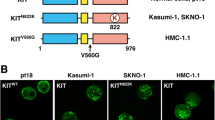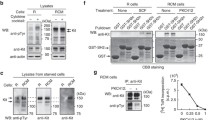Abstract
Oncogenic mutants of c-Kit are often found in mastocytosis, gastrointestinal stromal tumors and acute myeloid leukemia. The activation mechanism of the most commonly occurring mutation, D816V in exon 17 of c-Kit, has been well-studied while other mutations remain fairly uncharacterized in this respect. In this study, we show that the constitutive activity of the exon 11 mutant V560D is weaker than the D816V mutant. Phosphorylation of downstream signaling proteins induced by the ligand for c-Kit, stem cell factor, was stronger in c-Kit/V560D expressing cells than in cells expressing c-kit/D816V. Although cells expressing c-Kit/V560D showed increased ligand-independent proliferation and survival compared to wild-type c-Kit-expressing cells, these biological effects were weaker than in c-Kit/D816V-expressing cells. In contrast to cells expressing wild-type c-Kit, cells expressing c-Kit/V560D were independent of Src family kinases for downstream signaling. However, the independence of Src family kinases was not due to a Src-like kinase activity that c-Kit/D816V displayed. Point mutations that selectively block the association of PI3 kinase with c-Kit/V560D inhibited ligand-independent activation of the receptor, while inhibition of the kinase activity of PI3 kinase with pharmacological inhibitors did not affect the kinase activity of the receptor. This suggests a lipid kinase-independent key role of PI3 kinase in c-Kit/V560D-mediated oncogenic signal transduction. Thus, PI3 kinase is an attractive therapeutic target in malignancies induced by c-Kit mutations independent of its lipid kinase activity.






Similar content being viewed by others
References
Lennartsson J, Rönnstrand L (2012) Stem cell factor receptor/c-Kit: from basic science to clinical implications. Physiol Rev 92:1619–1649. doi:10.1152/physrev.00046.2011
Sun J, Pedersen M, Rönnstrand L (2009) The D816V mutation of c-Kit circumvents a requirement for Src family kinases in c-Kit signal transduction. J Biol Chem 284:11039–11047. doi:10.1074/jbc.M808058200
Hayakawa F, Towatari M, Kiyoi H et al (2000) Tandem-duplicated Flt3 constitutively activates STAT5 and MAP kinase and introduces autonomous cell growth in IL-3-dependent cell lines. Oncogene 19:624–631. doi:10.1038/sj.onc.1203354
Voytyuk O, Lennartsson J, Mogi A et al (2003) Src family kinases are involved in the differential signaling from two splice forms of c-Kit. J Biol Chem 278:9159–9166. doi:10.1074/jbc.M211726200
Sun J, Mohlin S, Lundby A et al (2014) The PI3-kinase isoform p110delta is essential for cell transformation induced by the D816V mutant of c-Kit in a lipid-kinase-independent manner. Oncogene 33:5360–5369. doi:10.1038/onc.2013.479
Blume-Jensen P, Siegbahn A, Stabel S, Heldin CH, Rönnstrand L (1993) Increased Kit/SCF receptor induced mitogenicity but abolished cell motility after inhibition of protein kinase C. EMBO J 12:4199–4209
Kazi JU, Sun J, Rönnstrand L (2013) The presence or absence of IL-3 during long-term culture of Flt3-ITD and c-Kit-D816V expressing Ba/F3 cells influences signaling outcome. Exp Hematol 41:585–587. doi:10.1016/j.exphem.2013.03.005
Hansen K, Johnell M, Siegbahn A et al (1996) Mutation of a Src phosphorylation site in the PDGF beta-receptor leads to increased PDGF-stimulated chemotaxis but decreased mitogenesis. EMBO J 15:5299–5313
Songyang Z, Carraway KL 3rd, Eck MJ et al (1995) Catalytic specificity of protein-tyrosine kinases is critical for selective signalling. Nature 373:536–539. doi:10.1038/373536a0
Gounder MM, Maki RG (2011) Molecular basis for primary and secondary tyrosine kinase inhibitor resistance in gastrointestinal stromal tumor. Cancer Chemother Pharmacol 67(Suppl 1):S25–S43. doi:10.1007/s00280-010-1526-3
Brahimi-Adouane S, Bachet JB, Tabone-Eglinger S et al (2013) Effects of endoplasmic reticulum stressors on maturation and signaling of hemizygous and heterozygous wild-type and mutant forms of KIT. Mol Oncol 7:323–333. doi:10.1016/j.molonc.2012.10.008
Lennartsson J, Blume-Jensen P, Hermanson M, Pontén E, Carlberg M, Rönnstrand L (1999) Phosphorylation of Shc by Src family kinases is necessary for stem cell factor receptor/c-kit mediated activation of the Ras/MAP kinase pathway and c-fos induction. Oncogene 18:5546–5553. doi:10.1038/sj.onc.1202929
Thömmes K, Lennartsson J, Carlberg M, Rönnstrand L (1999) Identification of Tyr-703 and Tyr-936 as the primary association sites for Grb2 and Grb7 in the c-Kit/stem cell factor receptor. Biochem J 341(Pt 1):211–216
Serve H, Hsu YC, Besmer P (1994) Tyrosine residue 719 of the c-kit receptor is essential for binding of the P85 subunit of phosphatidylinositol (PI) 3-kinase and for c-kit-associated PI 3-kinase activity in COS-1 cells. J Biol Chem 269:6026–6030
Adams SJ, Aydin IT, Celebi JT (2012) GAB2—a scaffolding protein in cancer. Mol Cancer Res 10:1265–1270. doi:10.1158/1541-7786.MCR-12-0352
Wills MK, Jones N (2012) Teaching an old dogma new tricks: twenty years of Shc adaptor signalling. Biochem J 447:1–16. doi:10.1042/BJ20120769
Grossmann KS, Rosario M, Birchmeier C, Birchmeier W (2010) The tyrosine phosphatase Shp2 in development and cancer. Adv Cancer Res 106:53–89. doi:10.1016/S0065-230X(10)06002-1
Hashimoto K, Matsumura I, Tsujimura T et al (2003) Necessity of tyrosine 719 and phosphatidylinositol 3′-kinase-mediated signal pathway in constitutive activation and oncogenic potential of c-kit receptor tyrosine kinase with the Asp814Val mutation. Blood 101:1094–1102. doi:10.1182/blood-2002-01-0177
Backer JM, Myers MG Jr, Shoelson SE et al (1992) Phosphatidylinositol 3′-kinase is activated by association with IRS-1 during insulin stimulation. EMBO J 11:3469–3479
Corless CL, Barnett CM, Heinrich MC (2011) Gastrointestinal stromal tumours: origin and molecular oncology. Nat Rev Cancer 11:865–878. doi:10.1038/nrc3143
Gajiwala KS, Wu JC, Christensen J et al (2009) KIT kinase mutants show unique mechanisms of drug resistance to imatinib and sunitinib in gastrointestinal stromal tumor patients. Proc Natl Acad Sci USA 106:1542–1547. doi:10.1073/pnas.0812413106
Mol CD, Dougan DR, Schneider TR et al (2004) Structural basis for the autoinhibition and STI-571 inhibition of c-Kit tyrosine kinase. J Biol Chem 279:31655–31663. doi:10.1074/jbc.M403319200
Foster R, Griffith R, Ferrao P, Ashman L (2004) Molecular basis of the constitutive activity and STI571 resistance of Asp816Val mutant KIT receptor tyrosine kinase. J Mol Gr Model 23:139–152. doi:10.1016/j.jmgm.2004.04.003
Kurtz JE, Ray-Coquard I (2012) PI3 kinase inhibitors in the clinic: an update. Anticancer Res 32:2463–2470
Sun J, Pedersen M, Rönnstrand L (2008) Gab2 is involved in differential phosphoinositide 3-kinase signaling by two splice forms of c-Kit. J Biol Chem 283:27444–27451. doi:10.1074/jbc.M709703200
Acknowledgments
This research was supported by grants from the Swedish Cancer Society, the Swedish Research Council, the Strategic Cancer Research Program at Lund University, BioCARE, ALF governmental clinical grant, Stiftelsen Olle Engkvist Byggmästare, Alfred Österlund Foundation, Gunnar Nilsson Cancer Society, Kungliga Fysiografiska Sällskapet i Lund, Ollie and Elof Ericssons Stiftelse, Åke-Wiberg Stiftelse, Lars Hiertas Minne Stiftelse, Harald Jeanssons Stiftelse and Harald och Greta Jeanssons Stiftelse, Swedish Childhood Cancer Foundation, MAS Cancer Foundation and SUS Hospital Funds.
Conflict of interest
The authors declare that they have no conflicts of interest.
Author information
Authors and Affiliations
Corresponding author
Rights and permissions
About this article
Cite this article
Lindblad, O., Kazi, J.U., Rönnstrand, L. et al. PI3 kinase is indispensable for oncogenic transformation by the V560D mutant of c-Kit in a kinase-independent manner. Cell. Mol. Life Sci. 72, 4399–4407 (2015). https://doi.org/10.1007/s00018-015-1944-9
Received:
Revised:
Accepted:
Published:
Issue Date:
DOI: https://doi.org/10.1007/s00018-015-1944-9




